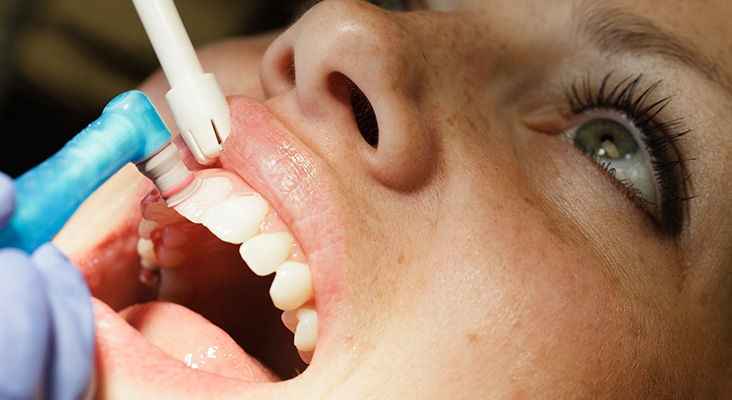Tipping the Scales Toward Remineralization
Remineralization is the natural reparative process that restores mineral ions to the tooth structure.

Remineralization is the natural reparative process that restores mineral ions to the tooth structure. Remineralization relies on calcium and phosphate ions to repopulate the enamel matrix by precipitation as pH increases. Saliva plays a significant role in remineralization because it contains both calcium and phosphate, which replenish the minerals lost due to acidic exposures when pH is high enough.
Photo Credit: IconicBestiary / iStock / Getty Images Plus

Effects of Diet
Salivary pH is easy to measure and is often reported in studies, but the dynamics of demineralization and remineralization occur at the tooth surface, which is continually coated by a protein-rich salivary pellicle or dental plaque. Typical saliva has a pH ranging from 6.8 to 7.4, with enamel demineralization occurring at pH levels below 5.5. Salivary acidity increases when food or drinks with low pH, such as soft drinks (pH of 2.7 to 3.5), coffee (pH of 2.4 to 3.3), sports drinks (pH of 2.3 to 4.4), wine (pH of 2.3 to 3.8), and beer (pH of 4.0 to 5.0) are consumed. Over time, drinking these beverages can cause acid-induced erosion. Additionally, patients who eat healthy diets filled with fruits and vegetables, such as apples, oranges, grapefruit, and tomatoes, also experience acidic oral environments, as these foods have pH levels ranging from 2.8 to 4.0. Dental professionals need to educate patients on the potential negative effects of eating a diet composed primarily of acidic foods, in addition to the more commonly discussed effects of avoiding sugary and acidic drinks.
Photo Credit: AlexRaths / iStock / Getty Images Plus

Remineralizing the Tooth Surface
Many strategies are available to slow or stop caries progression by remineralizing the tooth surface, but deciding which is right for each patient can be challenging. Patients at high caries risk; who consume diets high in carbohydrates; who have poor oral hygiene, dentinal hypersensitivity, or xerostomia; and/or who are undergoing orthodontic treatment may benefit from using products that enhance remineralization.
Photo Credit: LightFieldStudios / iStock / Getty Images Plus

Role of Fluoride
Fluoride has antimicrobial properties that inhibit cariogenic bacteria and help create an acid-resistant tooth structure. Fluoride inhibits demineralization by penetrating the tooth surface, adsorbing onto hydroxyapatite crystals and thus preventing dissolution of the tooth minerals. It enhances remineralization by attracting calcium ions. Consuming fluoridated water and using over-the-counter fluoride toothpastes reduce caries by maintaining a low concentration of salivary fluoride. Toothpastes containing calcium and phosphate, in addition to fluoride, may enhance remineralization. Prescription toothpastes containing 5,000 ppm fluoride (1.1% sodium fluoride) may be appropriate for at-risk patients. Mouthrinses containing .02% to .05% sodium fluoride may help reduce caries risk when used daily. Fluoride varnish (5% sodium fluoride) application is an in-office option that supports remineralization of the tooth surface.
Photo Credit: BanksPhotos / iStock / Getty Images Plus

Amorphous Calcium Phosphate
Amorphous calcium phosphate (ACP) is a combination of soluble salts of calcium and phosphorous. It releases calcium and phosphate ions to remineralize tooth structure. ACP may reduce dentinal hypersensitivity, restore enamel luster, and enhance fluoride delivery. ACP is found in toothpaste, chewing gum, fluoride varnish and gel, prophy paste, sealants, desensitizing products, and whitening systems.
Photo Credit: EnchantedFairy / iStock / Getty Images Plus

Amorphous Calcium Phosphate-Casein Phosphopeptide
Casein phosphopeptide (CPP) is a milk protein that stabilizes ACP. This combined product, CCP–ACP (Recaldent), can penetrate and remineralize enamel. CCP–ACP needs an acidic exposure to release the calcium and phosphate ions. It may be effective in reducing enamel subsurface lesions. Recaldent can be found in pastes, fluoride varnish, and chewing gum.
Photo Credit: baibaz / iStock / Getty Images Plus

Calcium Sodium Phosphosilicate
Calcium sodium phosphosilicate (NovaMin) is a synthetic material comprising calcium, sodium, phosphorus, and silica. It supports the creation of a natural crystalline hydroxycarbonate apatite layer, which is similar to natural tooth structure. In the presence of water or saliva, NovaMin releases sodium ions that increase pH. This initiates the release of calcium and phosphate, supporting remineralization. Novamin is found in toothpaste, prophy paste, desensitizing products, and air polishing powder.
Photo Credit: RichLegg / E+

Tri-Calcium Phosphate
Tri-calcium phosphate (TCP) works with fluoride and can potentially remineralize and strengthen enamel to a greater extent than fluoride alone. When TCP is used in toothpaste, it creates a protective barrier around calcium ions, stabilizing them in the presence of fluoride ions. When TCP contacts saliva, it causes the protective barrier to dissolve and release calcium, phosphate, and fluoride ions. TCP is available in prescription fluoride toothpaste and fluoride varnish.

